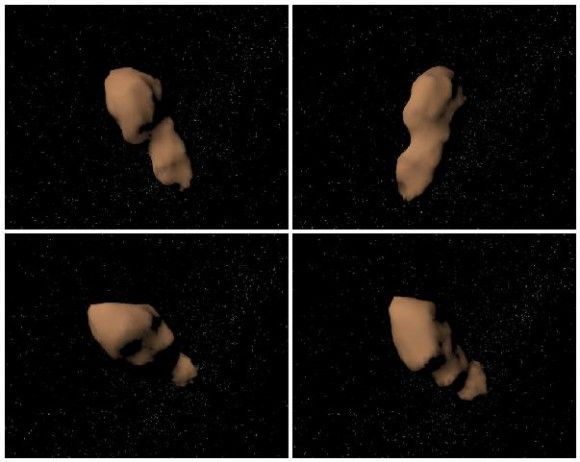
As doomsday 2012 approaches ever nearer, citizens of Earth get a rare treat today: a tremendous, long-studied asteroid named 4179 Toutatis will fly by Earth over the next 24 hours, according to National Geographic.
People hoping to see the asteroid buzz by the Earth can watch the show in prime time style by live streaming the asteroid online here at Slooh, or through the Virtual Telescope Project here. Slooh's live stream will be accompanied by real-time discussions with Slooh President, Patrick Paolucci, and Astronomy Magazine columnist, Bob Berman.
The asteroid will make its closest approach Tuesday night into Wednesday morning, and will come within 18 lunar distances of the planet. That's 4.3 million miles, or 18 times the distance between the earth and the moon. The first flyby of asteroid 4179 Toutatis will be at 3 p.m. EST; the second show will be at 10 p.m. EST.
Toutatis isn't close enough for observers to see it with the naked eye, and may be barely visible through binoculars, but it should be very bright through the Slooh telescopes as it's tracked, the site claims.
At nearly three miles wide, 4179 Toutatis is roughly half the size of the asteroid thought to have destroyed the dinosaurs.
The 4179 Toutatis asteroid was first discovered in 1934, according to the Los Angeles Times. However, the phenomenon was lost for over half a century until it was re-discovered by Christian Pollas in 1989, who is also responsible for naming it after a Gaulish God who was featured prominently in the French animated TV show, "Les aventures d'Asterix." The program concerns two heroes living in 50 B.C. who aren't afraid of anything, except the sky falling down, according to the Times.
"Since this object is the Apollo object with the smallest inclination known, it is a good candidate to fall on our heads one of these days ..." Pollas wrote, reported the Times.
Good news, though: Toutatis isn't expected to collide with Earth for at least 600 more years, said the Times.
With a shape that's been described as "peanut-like" or a "malformed potato," 4179 Toutatis is considered a "potentially hazardous" asteroid because it makes repeated passes by the Earth, about every four years.
"We will be tracking Asteroid Toutatis live from two observatory locations - Canary Islands, off the coast of Africa and Arizona," said Paolucci.
Astronomers are especially interested in this passage of Toutatis as they seek to discover what the asteroid consists of.
"By refining a model of the asteroid's rotation, they'll get a better idea of its composition, thereby gaining a greater understanding of the early solar system," noted UniverseToday.
"It's a very peculiar rotation state," Benner said. "It rotates very slowly and it tumbles in a manner somewhat similar to the way a football tumbles if you screw up a long pass."
Slooh's site will stream the asteroid's journey across Earth's sky in two separate views. In one, "the background stars will be tracked at their own rate and the asteroid will appear as an obvious streak or a moving time-lapse dot across the starry field," Berman said.
In Slooh's second view, "Toutatis itself will be tracked and held steady as a tiny pointlike object, while Earth's spin makes the background stars whiz by as streaks. Both methods will make the asteroid's speedy orbital motion obvious as it passes us in space," he added.
© 2025 Latin Times. All rights reserved. Do not reproduce without permission.




